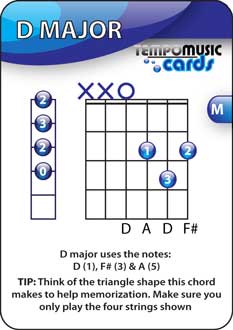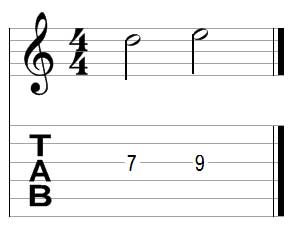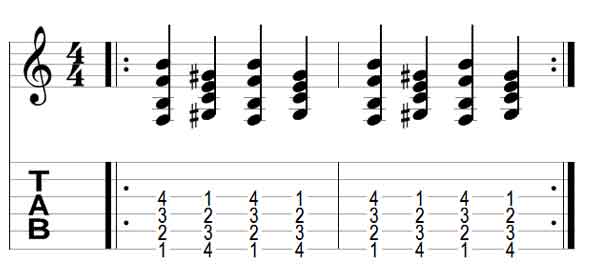In this lesson we will look at a few strategies to use for the best way to memorize chords on guitar. Keep in mind that everybody learns in slightly different ways so if you feel like modifying this method then do so. This method builds on other tips and lessons we have on memorizing chords and it’s worth checking them out as well. One of the most frustrating aspects of learning guitar is memorizing chords so this method should get you off to a flying start.
What it takes to memorize guitar chords
Tests have found that it takes at least 20 repetitions of any task for the brain to start the memorization process. This means if you only repeat something 5-10 times it won’t be enough to improve your skills or recall the information later on. Knowing that it takes at least 20 repetitions to start memorizing chords will help us ensure we’re practicing effectively.
Repetition is the key to memorization. If you practice something only once, there’s very little chance you will actually improve your skills and memory. On the other hand, if you repeat the exercise 20-50 times and do the same thing for a few days in a row you will clearly see improvements and increases in skill.
Key Tip #1: When practicing anything, repeat it at least 20 times before moving on
Our five senses are very tightly linked to our memory – think back of the last holiday you had at the beach – can you feel the warm sunlight, smell the salty air and hear the crashing waves? You are more likely to remember in detail an experience if you use more of your senses. Again we can use this when memorizing guitar chords. Instead of simply playing the chords without much thought we need to really ‘experience’ them. Listen carefully to each sound, feel the strings and frets under your fingers, look at the patterns your fingers make on the guitar. If you really pay attention to every detail you will improve your memorization of the chords. Alternatively, if you simply play the chords without much thought involved, there won’t be enough ‘links’ from your senses to help memorization.
Key Tip #2: The more senses you focus on when practicing, the more your brain will remember it
A final tip we can consider when thinking about memory is something called mnemonics. Mnemonics are simply tricks we can use to assist memorization. A detailed lesson on mnemonics for memorizing chords has already been written so check that out for more information.
Key Tip #3: Use mnemonic devices whenever possible to assist memorization
The best method to memorize chords on guitar
Now that you understand what it takes to memorize chords, let’s look at a simple step-by-step method to memorize them in the fastest and easiest way possible.
Step 1: Choose four chords to memorize
If you have our flash cards pack, simply pick out four random cards. Choosing chords at random will stop you from choosing what already feels familiar to you and will help you memorize chords you normally wouldn’t try. It also means you can repeat the method over and over and constantly learn new chords.
Step 2: Study the chords
Quite often beginners will skip this step – it’s a big reason why many beginners have so much trouble actually memorizing the chords! So don’t skip it!
The reason why we study each chord is to create ‘links’ to help your brain memorize them. Below is the flash card for D Major. Have a look at all the information on the card for a moment before reading on.

As you can see there’s quite a lot of information on this one chord. Here’s a quick list of points you should think about when looking at this card:
- The chord uses only four strings – D, G, B, E
- The notes used are D, F#, A
- The chord is a Major chord
- Only the first three fingers are used
- The finger pattern creates a triangle shape on the fretboard
- The Guitar TAB layout for the chord (shown on the left of the card) creates a pattern 0 2 3 2
- The lowest note is the low D string
Can you see how all this information help you memorize the chord? The more you understand the chord before you actually try to play it the easier you will find it to memorize. It’s not enough to simply know where to place your fingers, you need to really understand what is happening for your brain to memorize it faster.
After you spend a minute or two studying each chord you can move on to the next step
Step 3: Visualize playing the chords
Some people may read that and think ‘just play the chord!’, but remember that every time you add in these steps and involve more than one sense you will improve memorization. Visualizing the shapes you form on the fretboard and imagining playing them will actually help you play them! It may feel weird at first to imagine playing the chords, but it really does have an impact on how well you memorize chords.
Simply close your eyes and imagine playing the first chord. Then imagine changing your hand from the first chord to the second and so on until you repeat the four chords twice.
Step 4: Play the progression 20+ times
Now you can pick up the guitar and slowly move from one chord to the next. Notice how you don’t touch the guitar until step 4? That’s why this method is so effective – it makes use of all the available tricks to memorize chords instead of just trying to play them.
At this point it’s important you take your time and really focus on each chord. Remember to think about all your senses while playing as it will assist memorization. Play each chord four times before moving on to the next chord. Repeat the progression at least 20 times.
Step 5: Take a break
It’s important you give your brain time for the chords to sink in. Practicing them too much at the start won’t help you out. Simply taking a break for a couple minutes or having a quick walk is enough to refresh your mind. Don’t be fooled into thinking that an hour of constant practice will help you memorize chords. You’re better off with short and intense practice bursts rather than long and boring practice. If you really concentrate during the first four steps you should feel like you need a break at this point.
Simply take a couple minutes break from the chords to let them sink in.
Step 6: Repeat
Write down the chord progression you just practiced so you can come back to it later on. Plan on practicing the steps for that progression every day for the next week. At this point you can now start again at step 1 and pick out four new chords. Repeat the process with the new chords. Do this a few times until you feel like you can’t concentrate 100% on the task. Once you feel your concentrating fading it’s time to stop and move on to something else. Don’t overdo it as it will actually take you longer to memorize chords.
Why this method works to memorize chords
This method is effective in helping you memorize chords because it requires you to really think about the chords and not just play them. Too many beginners think that if they just play the chords that’s enough to memorize them. When you spend time thinking about the chords and studying them, you will actually find that you can recall the information easier and play them quicker.
Try out this method the next time you want to learn some new chords and you’ll find out just how effective it can be. If you haven’t already got our guitar flash cards pack, consider getting one as it contains 50 basic chords chosen specifically for beginners. It’s a great starting point when used with this method. Follow the advice and steps above and you will memorize chords in less time as well as learning more about each chord.





